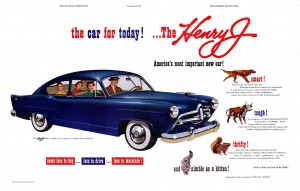Henry J Racing

Posted on May 25, 2013
By Ginny McPartland, Heritage writer (source)
- More than 60 years after Henry J. Kaiser debuted his namesake economy car, the “Henry J,” racing enthusiasts around the country still revere – and race – their hopped-up versions of the 1950s-built six-cylinder coupe.

- Although outclassed by any race car in this weekend’s Indianapolis 500, the Henry J has had its share of attention, if not glory, over the years. Henryjcars.com is devoted to everything Henry J, and enthusiasts meet there to share tips for restoration and to score rare replacement parts.
And yet, the Henry J was never meant to be a racing car.
Henry J. Kaiser and Joseph W. Frazer started the Kaiser-Frazer Corporation in 1945 to fill the demand after World War II for new automobiles. During the war, virtually no civilian vehicles were manufactured so factories could focus on the tanks, jeeps and trucks needed for combat.
The company produced a few different cars, including the Manhattan, a large sedan, the Darrin, a sports car, and the Henry J, a lower-priced vehicle for the masses. Kaiser believed that every American should be able to afford an automobile.
Who knew the car could compete?
 The fancy styling of today’s rejuvenated and supercharged Henry J is a far cry from what Henry Kaiser envisioned. In a magazine advertisement featuring the new model, the car was billed as: smart as an Irish setter; tough as a steer; thrifty as a squirrel and nimble as a kitten.
The fancy styling of today’s rejuvenated and supercharged Henry J is a far cry from what Henry Kaiser envisioned. In a magazine advertisement featuring the new model, the car was billed as: smart as an Irish setter; tough as a steer; thrifty as a squirrel and nimble as a kitten.
The ad pictured a family of four riding comfortably and sensibly in a blue Henry J with white-wall tires. Yet hot rodders soon discovered that the light weight and stripped down design of the Henry J made it the perfect candidate for stock car racing. A Web search reveals literally hundreds of hot rodders caught the bug soon after the Henry J’s release.
In June 1960, “Hot Rod Magazine” ran an article about a Henry J converted to a race car by Bill Waddill of Swartz Creek, Mich., not far from where Kaiser and Frazer manufactured the once tame vehicle.
According to “Hot Rod,” Waddill cut the 1953 Henry J in half at the door centerline and “chopped” the top but kept the original body proportions throughout the conversion. He competed in the 1959 Nationals in Detroit, “making a creditable showing before losing out in the run-offs.”
Waddill sold his Henry J in the early 1960s, and the new owner painted the car red and named it “Wicked Mary.”
 Indy 500 engineer invents heart/lung pump
Indy 500 engineer invents heart/lung pump
For their part in the creation of the Henry J – and the other Kaiser-Frazer vehicles manufactured in the 1940s and ’50s –Kaiser and Frazer were inducted in 2010 into the Automobile Hall of Fame in Dearborn, Mich., just outside of Detroit.
Although the Henry J could never qualify for a race such as the Indianapolis 500, Henry Kaiser, a man for all seasons, had his connection to the prestigious contest. One of Kaiser’s associates, Barney Navarro, considered one of the fathers of hot rodding, a racing engineer and inventor, developed the innovative 199 cubic-inch 6-cylinder Rambler motor producing more than 700 horsepower for the Indy 500 in 1967.
A speed boat racer, Navarro was at the helm of Kaiser’s Chrysler Hemi-powered boat when it set a speed record in the late 1950s. He also raced flat bottom boats with Henry Kaiser. At Kaiser’s behest, Navarro invented a heart and lung pump that was used from the late 1960s into the 1980s for open heart surgeries at Kaiser Foundation Hospitals.
So when actor Michael Peña says “ladies and gentlemen, start your engines” this weekend, know that the indefatigable Henry J. Kaiser left his mark at The Brickyard.
